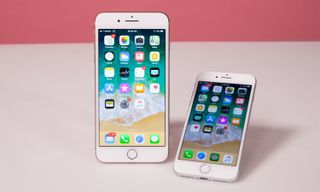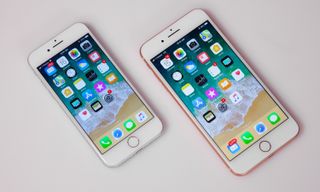iPhone 8 vs. iPhone 8 Plus: Get the Plus (Unless You're Nuts)
The iPhone 8 offers the same speed and image quality as the iPhone 8 Plus, but Apple's phablet outshines the regular model in three key ways.

I'm not saying the iPhone 8 is a bad phone, but if you don't get the iPhone 8 Plus instead, you might want to get your head checked.
The iPhone 8 ($699) and iPhone 8 Plus ($799) share many of the same key upgrades, including wireless charging, an A11 Bionic processor with record-breaking speed, and stronger glass on the front and back. Plus, thanks to a bigger and faster camera sensor, both of Apple's new flagships offer breathtaking image quality.
If you desperately need a phone that you can operate easily with one hand, I can see why you might want to get the 4.7-inch iPhone 8 instead of the bigger, 5.5-inch iPhone 8 Plus. The regular iPhone 8 also costs $100 less than the Plus. Heck, there are plenty of great small phones if that's your thing.
But there are three key reasons why you should buy the iPhone 8 Plus instead.
You get a bigger and sharper screen.
The displays on the iPhone 8 and iPhone 8 Plus offer a wide color gamut and True Tone technology, which automatically adjusts the white balance based on ambient lighting conditions. But that's where the similarities end.
MORE: iPhone 8 and iPhone 8 Plus Review
The iPhone 8 Plus sports a 5.5-inch display with 1920 x 1080 pixels, compared to the iPhone 8's relatively tiny 4.7-inch screen, with a lowly 1334 x 750 resolution. For those scoring at home, that's not full HD.
Sign up to get the BEST of Tom’s Guide direct to your inbox.
Upgrade your life with a daily dose of the biggest tech news, lifestyle hacks and our curated analysis. Be the first to know about cutting-edge gadgets and the hottest deals.

Whether you're streaming YouTube, flicking through the breathtaking photos or 4K video you can now capture, playing games, or just surfing the web, you'll appreciate the extra real estate and sharpness the iPhone 8 Plus provides.
The dual cameras make a huge difference.
Just like the iPhone 7 Plus, the iPhone 8 Plus comes with dual cameras, with a wide-angle lens and a telephoto lens.
This allows you to snap photos with a true 2x optical zoom, which means you can actually see your kid on the soccer field or capture a pic of that landmark without the usual digital-zoom distortion.

But the iPhone 8 Plus goes even further than its predecessor, building on the Portrait mode that helps you get more creative with your photos. Not only can you achieve an artistic bokeh effect that blurs out the background, but also the new Portrait Lighting effects let you make Photoshop-like adjustments with a single tap. For instance, you can switch from natural light to a brighter Stage Light or add more shadows with Contour Light.
Longer Battery Life
How much is over an hour of extra juice worth to you? On the Tom's Guide Battery Test, which involves continuous web surfing over 4G LTE, the iPhone 8 Plus lasted an impressive 11 hours and 16 minutes. That places the Plus on our list of longest-lasting phones.

The regular iPhone 8 endured for 9:54, which is better than the smartphone average but nearly an hour and a half behind the Plus' time.
Now, you could always get a $99 battery case for the regular iPhone, but at that point, you'll be paying the difference between the iPhone 8 and iPhone 8 Plus and you'll be carrying around a device that's just as bulky as the bigger phone (though not as tall or wide).
Bottom Line
The iPhone 8 is a good phone, but we gave it 8 out of 10 stars in our review for a reason, compared to 9 out of 10 for the iPhone 8 Plus.

The Plus gives you a bigger and sharper screen for work and play, as well as for enjoying a new breed of augmented reality apps. And the dual cameras give you a lot more creative flexibility. Add in over an hour of extra endurance, and splurging for the Plus is a no-brainer.
Credit: Shaun Lucas/Tom's Guide
Mark Spoonauer is the global editor in chief of Tom's Guide and has covered technology for over 20 years. In addition to overseeing the direction of Tom's Guide, Mark specializes in covering all things mobile, having reviewed dozens of smartphones and other gadgets. He has spoken at key industry events and appears regularly on TV to discuss the latest trends, including Cheddar, Fox Business and other outlets. Mark was previously editor in chief of Laptop Mag, and his work has appeared in Wired, Popular Science and Inc. Follow him on Twitter at @mspoonauer.

